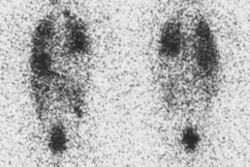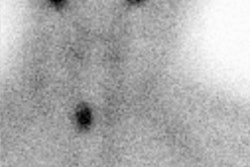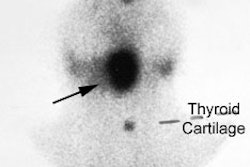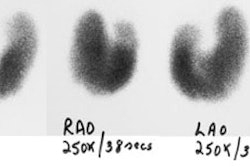TIRADS Classification:
A scoring system derived from five categories:If there are multiple nodules (four or more), only the four highest scoring nodules should be scored-
Composition:
- Cystic or completely cystic: 0 points
- Spongiform: 0 points
- Mixed cystic and solid: 1 point
- Solid or almost completely solid (less than 5% cystic): 2 points
- Anechoic: 0 points
- Hyper- or isoechoic: 1 point
- Hypoechoic: 2 points
- Very hypoechoic (the nodule is less reflective than the anterior neck muscles on every image): 3 points
- Wider than tall: 0 points
- Taller than wide (on axial image- AP length is larger than transverse width): 3 points
- Smooth: 0 points
- Ill-defined: 0 points
- Lobulated/irregular: 2 points
- Extra-thyroidal extension: 3 points
Echogenic foci: (choose 1 or more)
- None: 0 points
- Large comet tail artifact (colloid crystal): 0 points
- Macrocalcifications: 1 point
- Peripheral/rim calcifications: 2 points
- Punctate echogenic foci: 3 points
Classification:
TR1 (cancer risk 0.3%): 0 points. Benign- no FNA required
TR2 (cancer risk 1.5%): 2 points. Not suspicious- no FNA required
TR3 (cancer risk 4.8% (2.1-5%)): 3 points. Mildly suspicious- =
1.5 cm followup at 1, 3, and 5 years; = 2.5 cm FNA
TR4 (cancer risk 9.1% (5.1-20%)): 4-6 points. Moderately
suspicious- = 1 cm followup at 1, 2, 3, and 5 years; = 1.5 cm FNA
TR5 (cancer risk 35% (over 20%)): 7 points or more. Highly
suspicious- = 0.5 cm followup annually for up to 5 years; = 1 cm
FNA
The ACR recommends that FNAB should be limited to a maximum of
two nodules [3]. If there are multiple nodules, the two with the
highest ACR TIRADS grades should be sampled (rather than the two
largest). Any suspicious lymph nodes should also be sampled [3].
Nodule growth us defined as a 20% increase in at least two
dimensions and a minimal increase of 2 mm, or a 50% or greater
increase in nodule volume [2].
Nodules that do not grow over the course of 5 years may be
considered benign [2].
For TI-RADS, meta-analysis found a pooled estimated sensitivity
of 89% and a pooled specificity of 70% [5]. Using a cutoff of TR4
produced a pooled sensitivity of 90% and a specificity of 65%,
while a cutoff of TR5 had a pooled sensitivity of 61% and a
specificity of 88% [5].
NOTE: A recent article has suggested that TI-RADS is inadequate
for management of pediatric thyroid nodules because a high
percentage of cancers (22%) would be missed at the initial
encounter [4]. The article recommended changes to nodule
management guidelines in pediatric patients with biopsy of all
nodules larger than 4 cm (and consideration for surgical resection
due to the potential for a higher rate of false-negative FNA
results); adjustment of TR3 recommendations to perform FNA in
nodules 1.5 cm or larger (and follow if 1-1.4 cm); adjustment of
TR4 recommendations to perform FNA for nodules 1 cm or larger (and
follow if 0.5- 0.9 cm); and to consider biopsy for suspicious TR5
nodules that measure 0.5-0.9 cm [4].
REFERENCES:
(1) AJR 2017; Middleton WD, et al. Mutliinstitutional analysis
of thyroid nodule risk stratification using American College of
Radiology thyroid imaging reporting and data system. 208:
1331-1341
(2) Radiology 2018; Tessler FN, et al. Thyroid imaging reporting
and data system (TI_RADS): a users guide. 287: 29-36
(3) Radiographics 2019; Tappouni RR, et al. ACR TI-RADS:
pitfalls, solutions, and future directions. 39: 2040-2052
(4) Radiology 2020; Richman DM, et al. Assessment of the American
college of radiology thyroid imaging and reporting data system
(TI-RADS) for pediatric thyroid nodules. 294: 415-420
(5) AJR 2021; Li W, et al. Diagnsotic performance of American College of Radiology TI_RADS: a systematic review and meta-analysis. 216: 38-47



